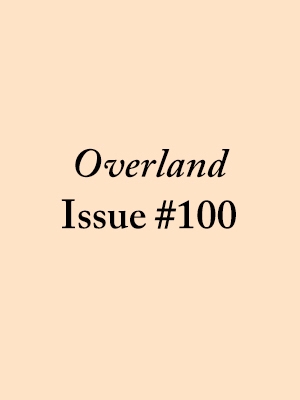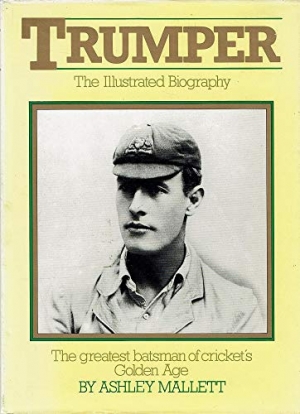Archive
My first contact with Arthur Phillips was through a note signed A.A.P., attached to a short story that an editor couldn’t find space for. The note pointed out that the story lacked reality, e.g. a child was allowed to sit in a hotel bar. When I finally got to meet A.A. Phillips, it was over a drink. The pleasure at meeting was enhanced by a child at the next table. I ribbed Arthur about this, telling him that he had sinned against the commandments of social realism. He allowed me my small victory (the story is still unpublished) and then told a number of very funny stories against himself. I knew him only slightly, but that minimal acquaintanceship showed him to be as extraordinary and as delightful in his living as he was in his writing.
... (read more)John McLaren reviews 'Overland 100', edited by Stephen Murray-Smith
Perth, like Sydney, is a city of water, but the water on display is safely enclosed in the reaches of the Swan. Here ferries and commuting speedboats plough their straight lines among flocks of red or blue sailed dinghies sailing and tacking in sudden turns like flocks of tropical fish. In Fremantle, sailors’ missions and clubs straggle around the side streets, and the mall on a Saturday afternoon is left to drunks and kids on BMX bikes. In the Book Market casual browsers can look through the latest publications from Australia and abroad, or climb upstairs to find a collection of raw socialist writings dedicated to Pat Troy, ‘one of Australia’s finest working class fighters’.
... (read more)Eric Lord reviews 'Trumper: The illustrated biography' by Ashley Mallett
Despite its faults, this book has the merit of being the first biography on the legendary Australian batsman, Victor Trumper (1877–1915). Young cricket lovers of today may well ask what feats of batsmanship Trumper performed to deserve this handsomely produced volume about him. After all, his test average was only 39.04, not to be spoken of in the same breath as Don Bradman’s 99.96.
... (read more)Spiro Zavos reviews 'Evil Angels: The death of Azaria Chamberlain in the central Australian desert, and the events leading to judgement' by John Bryson
John Bryson has tried to solve one of Australia’s great mysteries – how Azaria Chamberlain died. The cover of Evil Angels gives the clue to his answer. A bruise-coloured sky glowers over a stark, orange-brown desert. There is the twisted relic of a tree in the foreground and in front of it, like a spreading puddle of blood, the shadow of a dingo, its eyes on an evil slant.
... (read more)Jim Davidson reviews 'Tom Roberts 1856–1931: A catalogue raisonné' by Helen Topliss
When Scholars wandered across our television screens recently, palettes in hand, many were offended by the anachronisms: busts taking artists off to Sydney, or feminist polemics leading out to a car-clogged St Kilda Road. One Summer Again was an impression of Australia’s impressionists, and had the honesty to make that plain; and the more one reads about Roberts, Streeton, and Conder, the more it becomes clear that, in addition to communicating the raw energy and exuberance, the miniseries got the essentials absolutely right. Tom Roberts was as Chris Hallam, himself a onetime Englishman and art student, depicted him: confident, given to making pronouncements, a touch humourless perhaps, but a man with a high sense of purpose who easily moved among all kinds of people at all social levels.
... (read more)Australian involvement in World War I has in recent years attained a high profile in books, film and television. The trend has been to demythologise the legends of heroism and courage associated with war, and the theme often adopted is the rapid and brutal transformation from naivety to understanding of how baseless the myth was. Although this might be considered well covered ground, Geoff Page in his first novel, Benton’s Conviction, has returned to the war setting. However, because he concentrates on an aspect which hitherto has not been fully explored, and sustains the work with deft prose, Page has succeeded in producing a novel of originality and consistent interest.
... (read more)This is a first novel from Alexander Buzo, the playwright of the 1960s and 1970s who gave vitriol a new status in the Australian vernacular and who, through characters like Coralie Landsdowne (Coralie Landsdowne Says No) and Edward Martello (Martello Towers), raised pretentious speech to new levels of social acceptability. In a published comment on audience reception to Martello Towers, Buzo describes Edward Martello as ‘an educated ‘rake’, who is, in keeping with the style of the play, articulate beyond the grounds of naturalism’ and concludes, ‘Still, as long as they’re enjoying themselves’. Defensive disclaimers from writers hint at a nervousness which must, eventually, find its way into the writing usually in the form of overkill. The worst recent example of this is the introduction to Clive James’s Brilliant Creatures in which a rather affected statement of pre-emptive failure is intended to head the critics off at the pass if they were to do anything as unkind as suggest that the work was any more frivolous than intended by its author, who, of course, intended it to be.
... (read more)Jane Clark reviews 'City Bushmen: The Heidelberg School and the rural mythology' by Leigh Astbury
That Australia’s first national school of painters were ‘city bushmen’ is well documented. Tom Roberts began his career as a photographer in Collingwood, Frederick McCubbin in the family’s West Melbourne bakery and Arthur Streeton as an apprentice lithographer. Stories about their plein air painting excursions to Box Hill, Mentone, and Eaglemont are often told. The useful art historical label ‘The Heidelberg School’ first seems to have been used by a local journalist reviewing Streeton’s and Walter Withers’ work done chiefly in this attractive suburb where, with others of like inclination, they have established a summer congregation for out-of-door painting (The Australasian Critic, l July 1891). Leigh Astbury, however, defines his use of the term Heidelberg School ‘in its current broader sense, that is, artists of a more ‘progressive tendency working in Melbourne and Sydney in the 1880s and 1890s’.
... (read more)Paul Radley’s novels are about loss and growth. The first, the prize-winning Jack Rivers and Me, showed how ‘Peanut’ was forced to shed his imaginary companion as a part of his joining the world of school. My Blue-Checker Corker and Me dealt with a twelve-year-old boy’s reaction to grief at the loss of his racing pigeon. Now, in his latest, he takes us through five years in the lives of two mates from just before they leave school until one of them dies in the mud of New Guinea. The setting of the novel is again his fictitious township of Boomeroo, but the time is now the late thirties and first years of the war.
... (read more)John Hanrahan reviews 'The Oxford Companion to Australian Literature' edited by William H. Wilde, Joy Hooton, and Barry Andrews
This is a splendid book, by far the most important of the recent OUP contributions to the study of Australian literature. Everything that you ever wanted to know about Australian Literature. Comprehensive (amazingly), consistently lively, up to date, as far as I can judge, accurate.
I have played the usual reviewers’ game for a book like this – trying to ...










